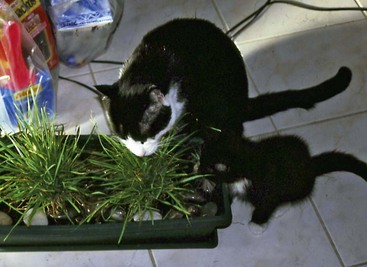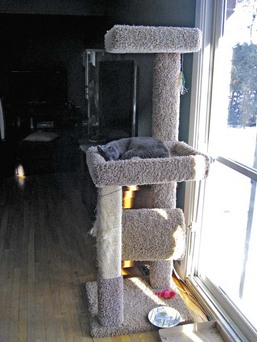CHAPTER 14 Behavioral Therapeutics
Behavior Modification
Since first coined by Thorndike in 1911,43 the term behavior modification has been used in many ways. Currently, it mainly refers to techniques for increasing adaptive behavior through reinforcement and decreasing maladaptive behavior through extinction or punishment (with much more emphasis on the former). This is because when aversive punishments are used (or misused), they can lead to more emotional distress and behavioral problems involving fear and anxiety. Most aversive techniques are inappropriate in context, duration, intensity, or time of application. Recent studies have confirmed that punishment-based training and confrontational techniques are more likely to lead to increased aggression and avoidance behaviors.
Environmental Management
Environmental management is usually necessary to prevent exposure to the stimulus, prevent access to locations where problems might arise, or provide outlets for expression of the behavior. For example, cats may need to be confined to avoid exposure or access to other cats, so cat enclosures made of metal or mesh can be attached to a door or window to allow the cat access to outdoors and some or all of the yard (Figure 14-1). Another option might be to fence off the garden to keep the cat enclosed.

FIGURE 14-1 A cat enclosure attached to a door or window allows for safe access to a stimulating environment outdoors.
Studies have investigated disease rates among animals in enriched environments versus those in standard housing. Enriched environments were found to decrease the incidence of gastric ulcers in rats35 and urinary tract disorders in cats4 and to improve the immune functioning of animals.39 Conversely, stress may alter immune function and has been shown to be a contributing or aggravating factor in gastrointestinal diseases, dermatologic conditions, respiratory and cardiac conditions, behavioral disorders, and a shortened life span.12,31,44
Enrichment might also delay the onset or lessen the effects of feline cognitive dysfunction. Studies in dogs and humans have shown that continued learning; physical exercise; and a change to a diet rich in antioxidants, essential fatty acids, and mitochondrial cofactors can have a positive effect on well-being,26,29 and the same may be true for cats.16
Appropriate enrichment may prevent some behaviors that are of concern to owners33,46 and lower stress, which may in turn lessen the chances of stress-related diseases such as interstitial cystitis.3–5
Enrichment can alleviate boredom and may play a role in preventing obesity and associated medical problems such as diabetes mellitus, hepatic lipidosis, and osteoarthritis.33 Stress has a negative role in the development of skin conditions such as infections and pruritus, feline lower urinary tract disease (FLUTD), and conditions such as irritable bowel syndrome.31,44 Addressing the environment of affected cats may help in reducing the number and severity of outbreaks of chronic diseases such as FLUTD.21
Any enrichment that is added to a cat’s environment must take into account the species-specific behavior of cats and the preferences of the individual cat. An elderly cat that has lived most of its life without feline company will have different needs than a young cat living in a multicat household. As discussed in previous chapters, cats are small, solitary, ambush hunters that have a crepuscular activity pattern. They have complex and highly variable social systems, depending on the spread and amount of resources such as food and shelter.9,11 Cats are territorial, with male territories overlapping several female territories.10 Enrichment devices and activities must address the biological needs of cats as well as the individual preferences to have a positive effect on feline welfare.
Hunting and Foraging Behavior
Wild and feral cats spend a significant amount of their waking hours foraging and hunting for food. It is therefore unsurprising that pet cats investigate new objects in their environments and engage in play with small, prey-size objects.17 Cats should not be allowed to play with human hands or feet because of the potential for injury resulting from their claws and teeth. However, toys that encourage the behaviors of the hunting sequence, such as stalking, rushing, pouncing, and biting, are popular with cats and their caregivers and provide opportunities for cats to engage in these normal behaviors. There are many types of toys that foster this type of play, including fishing rod–style toys and laser pointers. However, because the cat can never catch the light, some cats find laser toys frustrating. It can also be an issue for cats with the potential of developing an obsessive-compulsive disorder. Providing treats periodically during the game or afterwards may reduce frustration.
Wild and feral cats frequently eat grass.1 Cat grass offers a safe grazing choice for cats kept indoors (Figure 14-2). If the owner periodically moves the cat grass throughout the home, the cat will have to seek out the forage and therefore replicate natural behavior.
Resting Places
Cats spend an average of 2.8 hours resting and 7.8 hours sleeping during the day.1 Comfortable, protected areas should be provided for cats to sleep and rest. Many cats like high positions and will gravitate to beds in high places, such as in cupboards or on shelves. In multicat homes cats are less likely to compete over prime space when there are several choices, such as window ledges, cat climbing frames, and furniture to which cats are allowed access. Every room that cats visit frequently should offer them appropriate hiding and perching places, which can reduce stress (Figure 14-3).23 Cats are both predator and prey and may feel more secure in a place where they can watch activities without being watched themselves.
Stay updated, free articles. Join our Telegram channel

Full access? Get Clinical Tree




